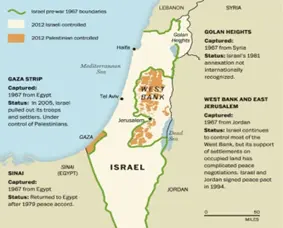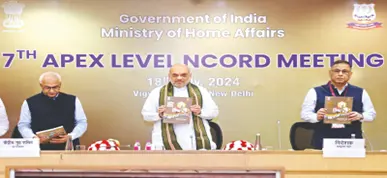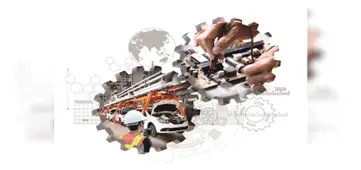Wednesday, 24th July 2024
Govt Servants and RSS Activities: What Rules Say
Why in the News?
- The Indian government has recently lifted a ban that restricted public servants from participating in activities related to the Rashtriya Swayamsevak Sangh (RSS).

What Do the Rules Say About Government Employees Joining the RSS?
- On 9th July 2024, the DoPT announced the removal of references to the RSS from Official Memorandums (OM) issued in 1966, 1970, and 1980.
- The RSS is no longer categorised as a "political" organisation, allowing central government employees to participate in its activities without facing penalties under Rule 5(1) of the Conduct Rules.
- However, this reclassification does not extend to the Jamaat-e-Islami, which remains a political organisation and thus prohibits government officials from participating in its activities.
- Rule 5 of the Central Civil Services (Conduct) Rules, 1964 prohibits government servants from associating with political parties or engaging in political activities.
Official Memorandums (OM) of 1966, 1970, and 1980:
- OM of 1966:
- Date: 30th November 1966
- Issued by: Ministry of Home Affairs (MHA)
- Content: Clarified the stance on government employees’ involvement with the RSS and Jamaat-e-Islami, labelling participation in these organisations as contrary to government policy.
- Reference: Rule 5 of the Central Civil Services (Conduct) Rules, 1964. It stated that involvement with these groups could lead to disciplinary action.
- Applicability: Also applies to All India Services (Conduct) Rules, 1968 for IAS, IPS, and Indian Forest Service officers.
- OM of 1970:
- Date: 25th July 1970
- Issued by: Ministry of Home Affairs (MHA)
- Content: Reinforced that government employees should face disciplinary actions for breaching the instructions issued on 30th November 1966.
- Context: During the Emergency (1975-1977), directives were issued against members of various groups, including RSS, Jamaat-e-Islami, Ananda Marg, and CPI-ML.
- OM of 1980:
- Date: 28th October 1980
- Issued by: Government
- Content: Emphasised the need for maintaining a secular perspective among government employees and highlighted the importance of eliminating communal sentiments and biases.
Rule 5 of Conduct Rules:
- Central Civil Services (Conduct) Rules, 1964: Prohibits government servants from associating with political parties or organisations involved in politics.
- All India Services (Conduct) Rules, 1968: Similar to the 1964 Rules, applicable to IAS, IPS, and Indian Forest Service officers.
- Prior Rules: Before the 1964 and 1968 Rules, the Government Servants' Conduct Rules, 1949, prohibited political activities by government employees.
- Violations and Consequences:
- Violations of Rule 5 could result in disciplinary action, including dismissal.
- Determining the political nature or association with the RSS was challenging due to its informal membership system.
What is Rashtriya Swayamsevak Sangh (RSS)?
- About:
- Founded: 1925 in Nagpur by Dr. K.B. Hedgewar
- Purpose: Hindu nationalist volunteer organisation aimed at promoting Hindutva, which emphasises Hindu cultural and national identity.
- Pre-Independence Era:
- Role: Played a significant role in the social and cultural mobilisation of Hindus, focusing on community service, education, and promotion of Hindu values.
- Post-Independence:
- Scrutiny: Faced scrutiny after India’s independence, particularly following the assassination of Mahatma Gandhi in 1948. The organisation was briefly banned but later reinstated.
- Ideology:
- Central Idea: Articulated by Vinayak Damodar Savarkar, promoting the notion that India is fundamentally a Hindu nation.
- Focus:
- Emphasises Indian culture and heritage, aiming to unify people under a common national identity.
- Engages in various social service activities, including education, health care, and disaster relief, promoting the concept of "Seva" (service) among its members.
- Contribution to Freedom Struggle:
- Although not directly involved in the Indian independence movement, the RSS contributed to the socio-political awakening of Hindus.
History of Ban on RSS:
- 1948: Banned after Gandhi’s assassination; lifted in 1949 following a pledge of loyalty to the Constitution.
- 1966: Government employees were prohibited from joining RSS; this ban was reiterated in 1970 and 1980.
- 1975-1977: Banned during Indira Gandhi’s Emergency; lifted in 1977.
- 1992: Banned after the Babri Masjid demolition; lifted in 1993 after a commission deemed the ban unjustified.
Structure and Functioning:
- Operates through a network of shakhas (branches) across India and abroad, focusing on physical, intellectual, and cultural training.
- Inspired other organisations such as Vishva Hindu Parishad (VHP), Bajrang Dal, and Akhil Bharatiya Vidyarthi Parishad (ABVP).
Political Influence:
- Considered the ideological parent of the Bharatiya Janata Party (BJP), which has been a major political force in India since the 1990s.
- The Department of Personnel and Training (DoPT) issued a directive allowing government employees to engage in Rashtriya Swayamsevak Sangh (RSS) activities without facing disciplinary action under the existing conduct rules.
Conclusion
The removal of the restriction on participating in RSS activities signifies a significant change in the government's approach to its conduct rules, reflecting a policy shift after several decades.
|
UPSC Civil Services Examination, Previous Year Question (PYQ) Prelims Q1. Who among the following is associated with ‘Songs from Prison’, a translation of ancient Indian religious lyrics in English? (2021)
Ans: (c)
Q2. With reference to the British colonial rule in India, consider the following statements: (2019)
Which of the statements given above are correct?
Ans: (b)
Mains Q:1 Bring out the constructive programmes of Mahatma Gandhi during Non-Cooperation Movement and Civil Disobedience Movement. (2021) Q:2 The banning of 'Jamaat-e — Islamic' in Jammu and Kashmir brought into focus the role of over- ground workers (OGWs) in assisting terrorist organisations. Examine the role played by OGWs in assisting terrorist organisations in insurgency affected areas. Discuss measures to neutralise the influence of OGWs. (2019) |
Source: IE
India’s Changing Position on Climate Change
Why in the news?
- The Indian government has articulated a markedly different stance on climate change in the Economic Survey (ES) 2023-24 presented in Parliament.
- This comes at a time when it is increasingly clear that the 1.5℃ target may be missed.
- The Economic Survey also critiques the proposed Carbon Border Adjustment Tax (CBAT) by the European Union (EU).

Key Aspects of the Economic Survey:
- Global Temperature Target
- Paris Agreement Goals: According to the 2015 Paris Agreement, nations must work to limit the rise in global average temperature to:
- Within 2℃ above pre-industrial levels (1850-1900 average), and
- Preferably within 1.5℃.
- Country Commitments: Each nation is required to prepare and implement an action plan contributing to this target.
- Paris Agreement Goals: According to the 2015 Paris Agreement, nations must work to limit the rise in global average temperature to:
- India’s Critique of Global Climate Change Discourse
- Equity Issues: India has criticised the global climate change framework for its inequity, particularly the lack of commitment from developed nations.
- Temperature Target Critique: The single global temperature target does not account for the complex interconnections between climate, ecology, and human well-being.
- Problems with Alternative Energy: Issues include the mining of critical minerals for batteries in underdeveloped regions, impacting local ecological health.
- Suggestions in the Economic Survey for Addressing Climate Change
- Lifestyle Changes: The ES advocates for lifestyle modifications and reducing overconsumption as a more sustainable approach than merely switching to alternative energy sources.
- Balanced Policies: Short-term policies focused on improving quality of life are suggested as a better insurance against climate change.
Carbon Border Adjustment Mechanism (CBAM):
- Overview: CBAM entails tariffs on energy-intensive goods imported into the EU, aimed at:
- Preventing competitive disadvantage for local producers of iron, steel, and aluminium, compared to producers in developing countries with looser emission standards.
- Implementation: Expected to come into force on January 1, 2026.
India’s Critique of CBAM:
- Contradiction to Paris Agreement: CBAM is seen as contrary to the Paris Agreement’s principle of Common but Differentiated Responsibilities (CBDR).
- Economic Impact on India: With 27% of India’s exports of iron, steel, and aluminium products worth $8.2 billion going to the EU in 2022, CBAM could strain India's financial resources for climate adaptation.
- Financial Needs: India requires $28 billion annually until 2070 to achieve net zero, with limited international financial support thus far.
Climate Adaptation and Mitigation: Flaws and Criticisms:
- Climate Strategies: Focus on transitioning energy sources, adopting regenerative practices, and protecting ecosystems.
- Criticisms:
- Inadequate Funds: Climate pledges are often insufficient, offered as loans with conditions, and aimed at profit rather than genuine green development.
- Voluntary Contributions: Discussions leading up to COP29 saw developed nations pushing for voluntary contributions to the New Collective Quantified Goal (NCQG), undermining global climate action efforts.
Analysis of Chapter 13 of the Economic Survey.
- Historical Emissions: The chapter highlights that developed nations have historically used global resources destructively, contributing significantly to the climate crisis. Developed countries often avoid full responsibility.
- Flaws in Climate Pledges: Pledged funds are often insufficient and offered as loans, with conditions that prioritise donor countries' interests and undermine genuine climate action.
- NCQG Controversy: The push for voluntary contributions to the NCQG by developed nations reflects a reluctance to commit to binding financial obligations, revealing a gap between climate rhetoric and financial commitments.
India’s Sustainable Ethos and Climate Commitment:
- Traditional Practices: India’s traditional sustainability practices include using natural materials, minimising waste, and valuing frugality.
- Modern Integration: India’s climate strategies should integrate these traditional practices with modern technological advancements for balanced development and environmental stewardship.
Suggestions for India’s Climate Strategy:
- Returning to Nature: Adopting sustainable practices aligned with nature, such as plant-based consumption and efficient agricultural production, is essential.
- Cost-Benefit Analysis: India should avoid unsustainable consumption patterns prevalent in the developed world and focus on optimal consumption choices.
- Mission LiFE: Integration of Mission LiFE into daily life through voluntary actions and policy measures is crucial, with a focus on addressing over-consumption and maintaining equanimity.
Conclusion
Developing countries like India face the complex challenge of balancing development with sustainability. By critically examining existing strategies and embracing traditional sustainable practices, India can navigate its path towards a greener future while achieving its developmental objectives.
|
UPSC Civil Services Examination, Previous Year Question (PYQ) Prelims Q.1 In the context of India’s preparation for Climate-Smart Agriculture, consider the following statements: (2021)
Which of the statements given above are correct?
Ans: (d)
Q.2 Which of the following best describes/describes the aim of ‘Green India Mission’ of the Government of India? (2016)
Select the correct answer using the code given below.
Ans: (c)
Q.3 With reference to ‘Global Climate Change Alliance’, which of the following statements is/are correct? (2017)
Select the correct answer using the code given below:
Ans: (a)
Mains Q.1 Describe the major outcomes of the 26th session of the Conference of the Parties (COP) to the United Nations Framework Convention on Climate Change (UNFCCC). What are the commitments made by India in this conference? (2021) Q.2 ‘Climate Change’ is a global problem. How will India be affected by climate change? How Himalayan and coastal states of India are affected by climate change? (2017) |
Source: IE
Union Budget 2024-25 – Part I
Why in the news?
- The Union Budget for the fiscal year 2024-25 was presented by Minister of Finance and Corporate Affairs Smt. Nirmala Sitharaman in Parliament.
- This budget outlines the government's financial plans and priorities for the year.
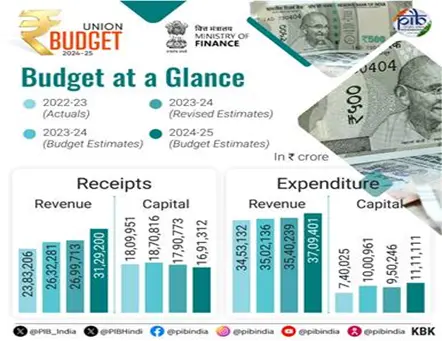
About the Union Budget/ 'Annual Financial Statement':
- Article 112 of the Constitution: Mandates the presentation of a statement of estimated receipts and expenditure for each financial year (April 1 to March 31).
- Components:
- Consolidated Fund: Includes all revenues, loans, and money received by the government.
- Contingency Fund: Used for unforeseen expenditures.
- Public Account: Includes funds received by the government that are held in trust.
Key Highlights of Union Budget 2024-2025 – Part I
- Focus Areas:
- Primary Groups: 'Garib' (Poor), 'Mahilayen' (Women), 'Yuva' (Youth), 'Annadata' (Farmer).
- Employment and Skilling:
- Prime Minister’s Package: Five schemes to support employment and skilling for 4.1 crore youth over five years, with a central outlay of ₹2 lakh crore.
- Allocation: ₹1.48 lakh crore for education, employment, and skilling.
Priorities in pursuit of Viksit Bharat:
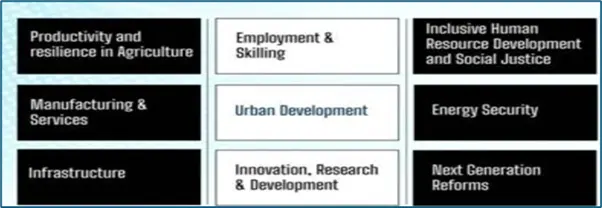
- Priority 1: Productivity and Resilience in Agriculture:
- New Varieties: Introduction of 109 high-yielding, climate-resilient varieties of 32 crops.
- Natural Farming: 1 crore farmers to be initiated into natural farming, with certification and branding.
- Bio-input Resource Centres: Establishment of 10,000 centres.
- Self-Sufficiency: Strengthening production and marketing of pulses and oilseeds.
- Digital Public Infrastructure (DPI): Implementation for agricultural coverage.
- Other Announcements:
- Issuance of Jan Samarth Kisan Credit Cards in 5 states.
- Financial support for Nucleus Breeding Centres for Shrimp Broodstocks.
- National Cooperation Policy to fast-track rural economic growth.
- Priority 2: Employment & Skilling
- Employment Linked Incentive Schemes: Implementation based on EPFO enrolment, recognizing first-time employees, and support for employees and employers.
- Women Workforce Participation: Establishment of working women hostels and creches.
- Skilling Initiatives:
- Industrial Training Institutes: Upgradation of 1,000 institutes.
- Model Skill Loan Scheme: Loans up to ₹7.5 lakh with government guarantee.
- Higher Education Loans: Financial support for up to ₹10 lakh for domestic higher education, with e-vouchers for annual interest subvention.
- Priority 3: Inclusive Human Resource Development and Social Justice
- Purvodaya: Plan for the development of Eastern India (Bihar, Jharkhand, West Bengal, Odisha, Andhra Pradesh) to enhance human resources, infrastructure, and economic opportunities.
- Pradhan Mantri Janjatiya Unnat Gram Abhiyan: For socio-economic upliftment of tribal communities in 63,000 villages, benefiting 5 crore people.
- Additional Announcements:
- Expansion of India Post Payment Bank branches in the Northeast.
- ₹2.66 lakh crore provision for rural development.
- ₹3 lakh crore for schemes benefitting women and girls.
- Priority 4: Manufacturing & Services
- MSME Support:
- Self-Financing Guarantee Fund: Guarantee cover up to ₹100 crore.
- Credit Assessment: Public sector banks to enhance in-house MSME credit assessment.
- Mudra Loans: Enhancement of Mudra loan limit to ₹20 lakh.
- Food Irradiation and Quality Testing: Financial support for setting up food irradiation units and quality testing labs.
- E-Commerce Export Hubs: Establishment in PPP mode.
- Internships: Scheme for internships in 500 top companies, providing a ₹5,000 monthly allowance.
- MSME Support:
- Priority 5: Urban Development
- Urban Housing:
- PM Awas Yojana Urban 2.0: Investment of ₹10 lakh crore to address housing needs of 1 crore urban poor and middle-class families, with central assistance of ₹2.2 lakh crore over 5 years.
- Water Supply and Sanitation: Projects for water supply, sewage treatment, and solid waste management in 100 large cities.
- PM SVANidhi: Support for street vendors and development of 100 weekly 'haats' or street food hubs over the next five years.
- Urban Housing:
Conclusion
The Union Budget 2024-25 emphasises growth in key areas such as agriculture, employment, skilling, social justice, manufacturing, and urban development, while also addressing rural and tribal upliftment. The allocation and initiatives reflect the government's commitment to balanced and inclusive growth, aligning with the broader vision of a Viksit Bharat.
|
UPSC Civil Services Examination, Previous Year Questions (PYQs) Prelims Q:1 Increase in absolute and per capita real GNP do not connote a higher level of economic development, if: (2018)
Ans: (c)
Q:2 In a given year in India, official poverty lines are higher in some States than in others because: (2019)
Ans: (b)
Mains Q.1 “Industrial growth rate has lagged behind in the overall growth of Gross-Domestic-Product (GDP) in the post-reform period” Give reasons. How far are the recent changes in Industrial Policy capable of increasing the industrial growth rate? (2017) Q.2 Do you agree that the Indian economy has recently experienced a V- shape recovery? Give reasons in support of your answer. (2021) |
Source: TH
Economic Survey 2023-24 Highlight – II
Why in the news?
- Recently, Union Finance Minister Nirmala Sitharaman has tabled the Economic Survey 2023-24, which projects a real GDP growth of 6.5 to 7 per cent.
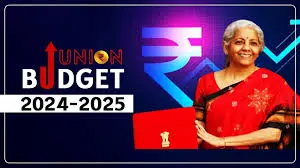
Key Highlights of Union Budget 2024-2025:
- Climate Change and Energy Transition:
- Climate Goals and Achievements:
- India is on track to meet its climate goals and is the only G20 nation aligned with the 2°C warming limit.
- The share of non-fossil sources in electricity generation has reached 45.4% as of May 2024.
- Emission Reductions:
- The emission intensity of GDP has been reduced by 33% from 2005 levels.
- Between 2005 and 2019, GDP grew at a CAGR of 7%, while emissions grew at 4%.
- Initiatives and Investments:
- Initiatives like the Coal Gasification Mission have contributed to significant energy savings and emissions reductions.
- Sovereign green bonds worth ₹16,000 crore and ₹20,000 crore have been issued in early 2023.
- Climate Goals and Achievements:
- Social Sector:
- Impact of Digitisation:
- The Gini coefficient, an indicator of inequality, has decreased in both rural (from 0.283 to 0.266) and urban areas (from 0.363 to 0.314).
- Healthcare and Education:
- The Ayushman Bharat scheme has issued over 34.7 crore cards and covered 7.37 crore hospital admissions, including 22 mental disorders.
- The 'Poshan Bhi Padhai Bhi' initiative aims to build a universal preschool network at Anganwadi Centres.
- The Vidyanjali program has enhanced educational experiences for over 1.44 crore students.
- Research and Development:
- R&D is thriving, with nearly 1 lakh patents granted in FY24.
- Under PM-AWAS-Gramin, 2.63 crore houses have been constructed, and the Gram Sadak Yojana has completed 15.14 lakh km of road construction.
- Impact of Digitisation:
- Employment and Skill Development:
- Labour Market Trends:
- The unemployment rate has declined to 3.2% in 2022-23.
- The workforce distribution includes 45% in agriculture, 11.4% in manufacturing, 28.9% in services, and 13% in construction.
- Female labour force participation has been increasing.
- Job Creation and Investment:
- The gig economy is projected to expand to 2.35 crore by 2029-30.
- Direct public investment equivalent to 2% of GDP could generate 11 million jobs, with a significant portion benefiting women.
- Labour Market Trends:
- Agriculture and Food Management:
- Sector Growth:
- The agriculture sector grew at an average annual rate of 4.18% over the last five years.
- Credit disbursed to agriculture reached ₹22.84 lakh crore as of January 2024, with 7.5 crore Kisan Credit Cards issued.
- Irrigation and Research:
- Micro irrigation coverage is at 90 lakh hectares. Investments in agricultural research have shown high returns.
- Sector Growth:
- Industry:
- Growth and Performance:
- The industrial sector contributed to a growth rate of 8.2% in FY24, with a notable 9.5% growth in industrial output.
- India's pharmaceutical market ranks third globally by volume, with a valuation of USD 50 billion.
- The electronics manufacturing sector holds a 3.7% global market share.
- Investment and Jobs:
- PLI schemes have attracted over ₹1.28 lakh crore in investments, leading to significant production and job creation.
- Growth and Performance:
- Services:
- Sector Contribution:
- The services sector contributes approximately 55% to GVA, recovering to pre-pandemic levels.
- India’s services exports represented 4.4% of global commercial services exports in 2022, with digital services exports increasing to 6.0% in 2023.
- Sector Growth:
- The aviation sector saw a 15% YoY increase in passengers, and air cargo grew by 7% YoY.
- The tourism industry welcomed over 92 lakh foreign tourists in 2023, a 43.5% increase from the previous year.
- Global Capability Centres in India have grown from over 1,000 in FY15 to more than 1,580 in FY23.
- Sector Contribution:
- Infrastructure:
- Development and Investment:
- National Highway construction pace has increased to around 34 km per day from 11.7 km per day in FY14.
- New terminal buildings at 21 airports have enhanced passenger capacity by approximately 62 million annually.
- Logistics and Clean Energy:
- India’s ranking in the World Bank Logistics Performance Index has improved to 22nd in 2023.
- Clean energy investments totaled ₹8.5 lakh crore between 2014 and 2023.
- Development and Investment:
- Climate Change and India:
- Flaws in Current Strategies:
- Global Applicability Issues: Existing climate strategies often overlook the specific needs of developing countries, applying solutions that may not fit diverse contexts.
- Overconsumption Focus: The Western approach typically addresses symptoms rather than the root cause—overconsumption—failing to tackle fundamental environmental issues.
- Need for Customised Solutions:
- One-Size-Fits-All Problems: Uniform climate policies are ineffective across varied national contexts. Developing countries need tailored approaches that suit their unique challenges.
- Empowering Developing Nations: Countries like India should have the autonomy to craft climate solutions that align with their individual needs, balancing development and sustainability.
- Flaws in Current Strategies:
Conclusion
The Economic Survey 2023-24 highlights India’s progress in climate action, social sector improvements, and economic growth. Key areas include renewable energy advancements, job creation, and infrastructure development. The survey underscores the need for tailored climate strategies and continued investment in sectors critical for sustained growth and development.
Source: TH
Supreme Court’s Split Verdict on Permission for GM Mustard
Why in the news?
- The Supreme Court has delivered a split verdict on the Centre’s 2022 decision granting conditional approval for the environmental release of genetically modified (GM) mustard crops.
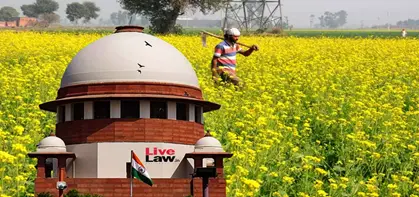
About GM Crops:
- Definition:
- Genetically Modified (GM) crops are planting whose DNA has been altered using genetic engineering techniques to introduce desirable traits.
- Benefits of GM Crops:
- Increased Yield: Higher production, enhancing food security.
- Pest and Disease Resistance: Reduced need for chemical pesticides.
- Herbicide Tolerance: More effective weed control.
- Enhanced Nutritional Content: Improved nutrient levels to combat malnutrition.
- Environmental Benefits: Lower chemical inputs reduce environmental impact.
- Concerns / Controversies:
- Environmental Impact: Potential effects on non-target species and biodiversity.
- Health Concerns: Public worry about long-term health effects despite research indicating safety.
- Economic Issues: Corporate control over GM seeds and the impact on small-scale farmers.
- Ethical and Labelling Issues: Debates on genetic manipulation and the need for clear labelling of GM products.
Regulations in India:
- Regulatory Bodies:
- Ministry of Environment, Forest, and Climate Change (MoEFCC): Oversees activities related to GMOs under the Environment (Protection) Act, 1986.
- Genetic Engineering Appraisal Committee (GEAC): Statutory body under MoEFCC responsible for reviewing and approving GMO-related activities.
- Food Safety and Standards Authority of India (FSSAI): Ensures GM foods comply with safety regulations.
- Current Status:
- Cotton is the only GM crop approved for commercial cultivation in India.
About GM Mustard:
- Background:
- In 2023, GEAC approved the commercial cultivation of Dhara Mustard Hybrid (DMH-11), developed by Delhi University scientists using genes from soil bacteria to enhance hybridization.
- Approval:
- GEAC approved the environmental release of DMH-11 for seed production and testing under ICAR guidelines and other regulations before commercial release.
Supreme Court’s Split Verdict on GM Mustard:
- Petitions:
- Activist Aruna Rodrigues and NGO 'Gene Campaign' called for a moratorium on GMO release until a comprehensive biosafety protocol is established.
- Divergent Opinions:
- Justice Nagarathna: Invalidated the October 2022 GEAC decisions due to procedural lapses, including the absence of a health department member and missing eight members from the meeting.
- Justice Karol: Found no arbitrariness in GEAC decisions, advocating for field trials with strict safeguards.
- Next Steps:
- The matter is referred to Chief Justice of India D Y Chandrachud for further adjudication.
- National Policy:
- Both justices emphasised the need for a national policy on GM crops.
- Directed the Centre to consult stakeholders and experts within four months to formulate this policy.
|
UPSC Civil Services Examination Previous Year Question (PYQ) Prelims Q1. Other than resistance to pests, what are the prospects for which genetically engineered plants have been created? (2012)
Select the correct answer using the codes given below:
Ans: C
Mains: Q:1 What are the present challenges before crop diversification? How do emerging technologies provide an opportunity for crop diversification? (2021) Q:2 What are the research and developmental achievements in applied biotechnology? How will these achievements help to uplift the poorer sections of the society? (2021) Q:3 How is science interwoven deeply with our lives? What are the striking changes in agriculture triggered by science-based technologies? (2020) Q:4 How did India benefit from the contributions of Sir M. Visvesvaraya and Dr. M.S. Swaminathan in the fields of water engineering and agricultural science respectively? (2019) |
Source: IE
Issue of Railway Safety in India
Why in the news?
- Recently, to the Union Budget 2024-25, the Ministry of Railways has received a record allocation of over ₹2.55 lakh crore in financial year 2024-25, which is a jump of 5.85% from the previous year’s ₹2.41 lakh crore.
- However, the Economic Survey 2023-24 indicates limited progress on safety-related works such as deployment of automatic train protection system Kavach and overhaul of signalling systems at all stations.
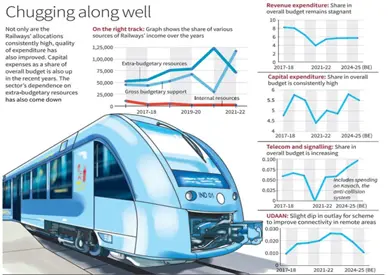
Issue of Railway Safety in India:
- Total Number of Train Accidents: From 2015-16 to 2021-22, India witnessed 449 train accidents, excluding those on Konkan Railways.
- Most Prominent Categories of Train Accidents:
- Derailments: The most common cause, accounting for nearly three-fourths of 217 train accidents from 2017-18 to 2020-21, as per the CAG's Performance Audit.
- Level Crossing Accidents: The second most common cause.
- Fire and Collisions: Other significant causes.
- Major Factors Responsible for Derailments:
- Maintenance of tracks
- Deviation of track parameters beyond permissible limits
- Bad driving/over speeding
Recommendations of the CAG:
- Strong Monitoring Mechanism: Ensure timely maintenance using fully mechanised methods and improved technologies.
- Rashtriya Rail Sanraksha Kosh (RRSK): Follow guiding principles for fund deployment.
- Detailed Outcome Framework: Prepare frameworks for each safety work item.
- Accident Inquiries: Adhere to scheduled timelines for conducting and finalising accident inquiries.
Highlights of the Union Budget 2024-25
- Capital Expenditure:
- Total Outlay: ₹2.65 lakh crore, with ₹2.52 lakh crore from general revenue, ₹200 crore from the Nirbhaya Fund, ₹3,000 crore from internal resources, and ₹10,000 crore from extra budgetary resources.
- Usage: Focus on safety works, asset creation, acquisitions, construction, and replacement.
- Historical Comparison:
- In 2014, only ₹35,000 crore was spent on capital expenditure for railways.
- Operating Ratio:
- Definition: The rupees spent to earn every hundred rupees.
- Current Ratio:
- 98.22% in FY 2024-25 Budget Estimates, indicating that for every 100 rupees spent, railways earn 98.22 rupees.
- This reflects the management's efficiency in cost control and revenue generation.
- Kavach Installation:
- Components: Includes hardware, software, and optical fibre.
- Challenge: Integrating diverse railway networks.
- Progress: With approvals for Kavach 4.0, installation is expected to accelerate.
Highlights of the Economic Survey 2023-24:
- Slow Pace of Kavach Installation:
- Deployment: 1,465 route km in the South-Central Railway, only 2.14% of the total 68,426 route km and 7,349 railway stations.
- Switch from Mechanical Signalling:
- Current Status: Eight out of 17 operational railway zones are free from mechanical signalling.
- Progress: Only 46% of 7,325 railway stations have transitioned to electronic interlocking systems.
- Capex Deployment:
- Increase: 77% rise over the past five years, reaching ₹2.62 lakh crore in FY24.
- Investments: Significant focus on new lines, gauge conversion, and doubling.
- Automatic Block Signalling (ABS) Installation:
- System: Uses automatic signals to regulate train passage between blocks, preventing collisions.
- Current Status: Commissioned on only 6.47% of the total railway length.
|
UPSC Civil Services Examination, Previous Year Question (PYQ) Prelims: Q:1 Consider the following communication technologies: (2022)
Which of the above are considered Short-Range devices/technologies?
Ans: (d)
Mains: Q:1 The setting up of a Rail Tariff Authority to regulate fares will subject the cash strapped Indian Railways to demand subsidy for the obligation to operate nonprofitable routes and services. Taking into account the experience in the power sector, discuss if the proposed reform is expected to benefit the consumers, the Indian Railways or the private container operators. (2014) |
Source: TH
Kalaripayattu
Why in the news?
- The Union Minister for Youth Affairs and Sports announced in the Lok Sabha that the Indian Kalaripayattu Federation has been recognized as the Regional Sports Federation to promote Kalaripayattu in India.

About Kalaripayattu:
- Kalaripayattu is a traditional martial art originating from Kerala.
- According to mythology, it was promulgated by the warrior sage Parasurama.
- The term "Kalaripayattu" combines "kalari" (place of combat) and "payattu" (fighting) in Malayalam.
Stages of Kalaripayattu:
- Maippayattu: Body conditioning exercises.
- Kolthari: Use of wooden weapons.
- Angathari: Use of sharp metallic weapons.
- Verumkai: Bare-handed defence and attack.
Features and Significance:
- Training in Kalaripayattu is inclusive of women.
- Major ethnic styles include Vattenthirippu, Arappukkai, and Pillathangi in northern Kerala.
- Benefits include enhanced strength, stamina, defence techniques, reflexes, flexibility, confidence, concentration, physical culture, and mental discipline.
- Kalaripayattu is often compared to Yoga in action and is unique for its association with a treatment branch, potentially contributing to sports medicine.
Source: PIB
Air Breathing Propulsion System
Why in the News?
- Indian Space Research Organisation (ISRO) has successfully carried out the second experimental flight for demonstrating Air Breathing Propulsion Technology.
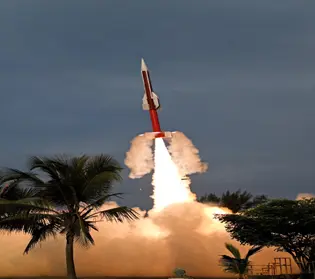
Air Breathing Propulsion System:
- Definition:
- The Air Breathing Propulsion System uses atmospheric oxygen as an oxidiser to burn the fuel, eliminating the need for an on-board oxidiser.
- This innovation makes rockets significantly lighter and more efficient.
- Operational Range:
- Effective within the denser layers of Earth's atmosphere (up to 70 km altitude).
- Beyond this altitude, rockets must switch to traditional propulsion systems that carry both fuel and oxidiser.
Types of Air Breathing Propulsion:
- Ramjet:
- Function: Operates on the principle of supersonic combustion without any moving parts.
- Mechanism: Relies solely on the forward motion of the engine to compress incoming air.
- Scramjet:
- Function: An advanced ramjet that generates thrust through supersonic air flow and combustion.
- Speed: Performs best at hypersonic speeds (greater than Mach 5).
- Achievement: In 2023, India became the fourth country to demonstrate successful flight testing of a Scramjet Engine.
- Dual-Mode Ramjet (DMRJ):
- Function: Transitions from a ramjet to a scramjet in the Mach 4-8 range.
- Capabilities: Operates efficiently in both subsonic and supersonic combustor modes.
Significance:
- The successful demonstration of air breathing propulsion systems represents a major advancement in rocket technology, improving efficiency and reducing the weight of rockets.
Source: TH
World’s Forests 2024 Report
Why in the news?
- Titled “The State of the World’s Forests,” the report highlights both encouraging trends in reducing deforestation and ongoing threats posed by climate change, wildfires, and pests.
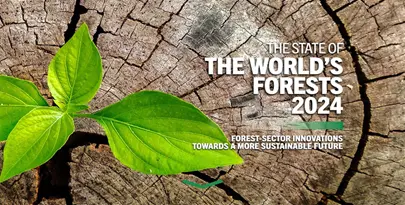
Key highlights
- Deforestation Rate: Declined to 10.2 million hectares (ha) per year in 2015–2020 from 15.8 million ha per year in 1990–2000.
- India's Ranking: Ranked 3rd for average annual net gain in forest area from 2010-2020.
- Non-Timber Forest Products: Support livelihoods of about 275 million people in India.
Need for Innovation in Forest Sector
- Climate Change Related Stress: Innovative Forest and land management strategies are needed for resilience against wildfires and pests.
- Shift Towards Bioeconomy: A zero-carbon bioeconomy requires innovation for diverse, efficient wood-based product uses.
- Opportunity from Non-Wood Forest Products: Many wild forest-based foods, including fish, are rich in micronutrients and have high nutritional content.
Five Types of Innovation Enhancing Potential of Forests and Trees to Address Global Challenges
- Technological:
- Remote-sensing and cloud computing generate high-quality forest data, thereby improving forest management processes.
- For example, NASA and ESA Landsat and Copernicus programs.
- Social, Policy, and Institutional:
- Interrelated and dynamic innovations to better engage women, youth, and Indigenous People.
- For example, India's Joint Forest Management Programme mandates 1/3rd female representation on committees.
- Financial:
- Innovations to enhance the value of standing forests and boost restoration efforts. For example, innovations like SCRIPT (Soft Commodity Risk Platform).
Barriers to Development of Innovations in the Forest Sector:
- Lack of Innovation Culture: Discourages curiosity, creativity, and risk-taking.
- Capital Limitations:
- Human Capital: Deficient skills among stakeholders.
- Natural Capital: Limited access to forest resources.
- Social Capital: Restricted tenure rights affecting resource utilisation.
- Lack of Policy Support: Impacts technology adoption and implementation.
Recommendations to Scale Up Innovation:
- Recognize and Reward Innovation: Fostering a culture that encourages and values innovative efforts.
- Boost Skills, Capabilities, and Knowledge: Ensuring forest-sector stakeholders have the necessary capacity to manage the creation and adoption of innovations.
- Provide Opportunities for Knowledge and Technology Transfer: Building appropriate safeguards to facilitate the transfer of knowledge and technology.
- Ensure Universally Accessible Financial Resources: Making financial resources available to support innovation and development in the forest sector.
Source: DTE
Revolutionising Growth: The Impact of India's Services
Context:
- Recently, sectors like finance, healthcare, IT, and tourism have become major drivers of growth and innovation.
- With investments in digital infrastructure, skill development, and streamlined regulations, India can maximise the service sector's potential for economic and social progress.

What is the Contribution of the Services Sector to India’s Economy (Economic Survey 2023-24)?
- The Economic Survey 2023-24, presented by the Union Minister of Finance and Corporate Affairs, highlights the vital role of the services sector in India’s economic growth over the past thirty years.
- Contributing approximately 55% to India’s economy in FY24, the services sector has flourished due to policy reforms, enhanced infrastructure, and improved logistics.
- A notable transformation has occurred with the rapid expansion of digital services, including online payments, e-commerce, and entertainment platforms.
- The services sector has been a consistent driver of growth, with its Gross Value Added (GVA) contribution increasing significantly. In FY24, the sector grew by 7.6%, and gross GST collections reached USD 241.27 billion (₹20.18 lakh crore), marking an 11.7% increase from FY23.
- Post-pandemic, services exports have sustained steady momentum, accounting for 44% of India’s total exports in FY24. India ranks fifth in services exports, following the European Union (excluding intra-EU trade), the US, the UK, and China.
- The growth of the services sector is primarily driven by rising demands for medical, legal, entertainment, accounting, and other personal services. This growth stems from increasing personal incomes and the outsourcing of business processes by expanding firms.
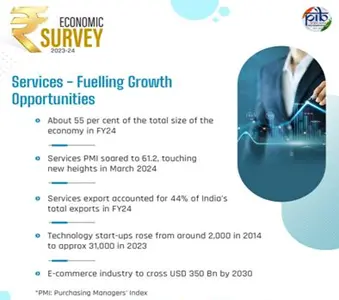
What is the Potential of India’s Major Services Sectors?
- Tourism:
- The tourism sector, which accounted for about 13% of India’s employment in 2020-21, presents significant job creation potential.
- It encompasses hospitality, travel, cultural, heritage, and religious tourism, providing diverse opportunities for roles such as tour guides, travel agents, and local artisans, especially for low to medium-skilled workers.
- Success in these roles’ hinges on strong interpersonal, management, and experiential skills, crucial for enhancing service quality and visitor satisfaction.
- India’s attractions — including ecotourism in Kaziranga National Park, cultural tourism in Varanasi, backwater tourism in Kerala, and adventure tourism in Goa — offer immense potential for growth and employment.
- Aviation:
- India’s aviation industry excels in gender diversity, with women making up 15% of pilots, significantly higher than the global average.
- As the sector continues to grow, there will be a rising demand for crew members, ground staff, and flight attendants.
- Continued investment in training and recruitment will be essential for the sector’s future.
- e-Commerce:
- Representing over 10% of the economy and about 8% of the workforce, the retail sector is experiencing a digital revolution with platforms like the Open Network for Digital Commerce transforming small retailer-consumer interactions.
- By joining e-commerce platforms, small retailers can broaden their market reach, improve efficiency, and create new job opportunities in logistics, customer service, and technology.
- Financial and Tech Services:
- The financial, business, and tech services sectors offer high-skill employment and abundant opportunities for innovation and start-ups.
- Over the past decade, employment in business services has nearly doubled due to digitization, technological advances, and supportive government policies.
- While AI may present challenges to India’s services export growth, it will also drive demand for new skills in cybersecurity, data privacy, and advanced analytics
What is the Major Areas of Concerns Regarding Growth of the Services Sector
- Lack of Skilled Workforce:
- India produces approximately 2.2 million STEM graduates, post-graduates, and PhDs annually. Despite this, a significant portion of them remains unemployable due to inadequate training.
- The Government is addressing this issue through skill development initiatives such as Skill India and the National Education Policy 2020, aimed at equipping the workforce with essential skills.
- Service Sector - A Segmented One:
- India’s service sector is currently fragmented, with growth concentrated in high-tech services, while job creation is predominantly in low value-added, low-skill services.
- Although back-office services have the potential to create numerous jobs, it may take 10-15 years for these roles to evolve into viable alternatives for broader employment.
- Access to Financial Resources:
- Accessing finance remains challenging, particularly for small and medium enterprises (SMEs) within the services sector.
- Initiatives such as Mudra Yojana, Start-up India, and Stand-up India aim to facilitate credit accessibility.
- Key areas needing improvement include streamlining loan processes, expanding credit guarantee schemes, adopting alternative credit appraisal methods, and innovating supply chain financing.
- Complex Regulatory Frameworks:
- Initiatives like GST simplification, Start-up India, and the Real Estate (Regulation and Development) Act have made progress, but further simplification is necessary.
- Addressing this involves creating single-window systems, streamlining legal provisions, and digitising government processes at all administrative levels to enhance economic efficiency.
- Data Protection:
- With increased digitization, data privacy and cybersecurity have become critical concerns.
- The Government is leading efforts to implement data protection laws and enhance cybersecurity policies to safeguard consumer data.
- Ensuring robust security measures, compliance with privacy regulations, and fostering innovation in security technologies are essential for securely embracing technological advancements.
- External Economic Uncertainties:
- Short-term global economic fluctuations and commodity price uncertainties pose significant challenges to input costs and demand for services.
- Maintaining positive demand trends and managing rising costs and competitive pressures are crucial for the services sector's sustained growth and resilience in the near future.
Way Forward:
- Value Addition, High Productivity, and Upskilling for Youth:
- Emphasise upskilling and efficient resource allocation to enhance personal and national productivity.
- A well-educated and healthy population is crucial for driving productivity and contributing significantly to value addition.
- Increased value addition improves product and service effectiveness, benefiting various industries.
- Upgrading Sector-wise Infrastructure:
- To translate sector-specific skills into effective job opportunities and industry growth, upgrading infrastructure is vital.
- For instance, initiatives like ‘Hunar Se Rozgar Tak’ and the Incredible India Tourism Facilitator Certificate Programme are beneficial for the tourism sector.
- Concurrently, infrastructure development is supported by increased funding for tourism projects and the launch of schemes like Swadesh Darshan and PRASHAD.
- Guidance for Boosting the e-Commerce Sector:
- Online retailers face challenges with technical aspects of digital selling, cataloguing, and data privacy.
- Support systems similar to ‘Vyapaar Gyan Kendras,’ modelled after Krishi Vigyan Kendras for agriculture, could simplify onboarding, provide guidance, and offer ongoing assistance.
- These centres would facilitate the transition of retailers to digital platforms, promoting a more inclusive economic landscape.
- Addressing Logistics Concerns:
- The logistics sector has significant employment potential for medium-skilled workers.
- Adopting innovative strategies such as using inland waterways, digital platforms for route optimization, dynamic freight bookings, automated cargo management, and streamlined passenger scheduling can transform logistics infrastructure.
- A Productivity-Linked Income (PLI) Scheme for Services:
- Institutionalise a productivity-linked income scheme for the services sector to reward companies that increase labour productivity through skilling, training, or innovative R&D.
- Companies showing notable improvements should receive tax benefits on sales/revenues, incentivizing exploration of innovative skilling options and enhancing workforce productivity.
- Maintaining Pace with Latest Technologies:
- Emerging job demands in the services sector require advanced and focused skills.
- The World Economic Forum highlights a shift towards cognitive abilities (complex problem-solving and creative thinking), digital literacy, and proficiency in AI and big data.
- Key focus areas include blockchain, AI, machine learning, Internet of Things, cybersecurity, cloud computing, big data analytics, augmented reality, virtual reality, 3D printing, and web and mobile development.
Conclusion
The services sector, if leveraged effectively, offers significant potential for broad-based employment generation, blending innovation with opportunity to ensure that every skill contributes to economic growth. Achieving this requires ongoing and seamless collaboration among industry, academic institutions, skilling organisations, and government bodies at all levels.
|
UPSC Civil Services Examination, Previous Year Questions (PYQs) Mains: Q.1 The need for cooperation among various service sectors has been an inherent component of development discourse. Partnership bridges the gap among the sectors. It also sets in motion a culture of ‘collaboration’ and ‘team spirit’. In the light of statements above examine India’s development process. (2019) Q.2 Normally countries shift from agriculture to industry and then later to services, but India shifted directly from agriculture to services. What are the reasons for the huge growth of services vis-a-vis industry in the country? Can India become a developed country without a strong industrial base? (2014) |
Source: TH
Share the article
Edukemy’s Current Affairs Quiz is published with multiple choice questions for UPSC exams
MCQ
Get Latest Updates on Offers, Event dates, and free Mentorship sessions.

Get in touch with our Expert Academic Counsellors 👋
FAQs
UPSC Daily Current Affairs focuses on learning current events on a daily basis. An aspirant needs to study regular and updated information about current events, news, and relevant topics that are important for UPSC aspirants. It covers national and international affairs, government policies, socio-economic issues, science and technology advancements, and more.
UPSC Daily Current Affairs provides aspirants with a concise and comprehensive overview of the latest happenings and developments across various fields. It helps aspirants stay updated with current affairs and provides them with valuable insights and analysis, which are essential for answering questions in the UPSC examinations. It enhances their knowledge, analytical skills, and ability to connect current affairs with the UPSC syllabus.
UPSC Daily Current Affairs covers a wide range of topics, including politics, economics, science and technology, environment, social issues, governance, international relations, and more. It offers news summaries, in-depth analyses, editorials, opinion pieces, and relevant study materials. It also provides practice questions and quizzes to help aspirants test their understanding of current affairs.
Edukemy's UPSC Daily Current Affairs can be accessed through:
- UPSC Daily Current Affairs can be accessed through Current Affairs tab at the top of the Main Page of Edukemy.
- Edukemy Mobile app: The Daily Current Affairs can also be access through Edukemy Mobile App.
- Social media: Follow Edukemy’s official social media accounts or pages that provide UPSC Daily Current Affairs updates, including Facebook, Twitter, or Telegram channels.

